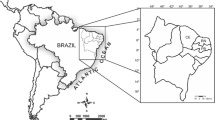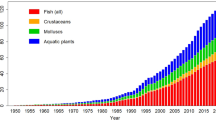Abstract
The recent decrease in Gracilaria culture production and value in Taiwan were evaluated from statistical data and from interviews with local fishermen. Reasons are: 1) during 1986–87, many Gracilaria culture ponds were transformed to grow grass shrimp (Penaeus monodon) in monoculture, but disease of the shrimp occurring soon after stopped such production and Gracilaria culture took over, but 2) due to manpower shortage, Gracilaria-farmers prefer to sell their crops to abalone farmers and not to agar factories. Since Gracilaria as abalone feed is cheeper than for agar production, the value of algal crop decreased.
Similar content being viewed by others
References
Chiang, Y. M., 1981. Cultivation of Gracilaria (Rhodophycophyta, Gigartinales) in Taiwan. Proc. int. Seaweed Symp. 10: 569–574.
Chiang, Y. M., 1984. Seaweed aquaculture and its associated problems in the Republic of China. TML Conference Proceedings 1: 99–109.
Chiang, Y. M. & J. L. Lin, 1989. Nitrate uptake by nitrogen-starved plants of the red alga Gracilaria tenuistipitata var. liui. Jpn. J. Phycol. 37: 187–193.
Taiwan Fisheries Bureau, 1981–1990. Taiwan Fishery Yearbook.
Author information
Authors and Affiliations
Rights and permissions
About this article
Cite this article
Ajisaka, T., Chiang, YM. Recent status of Gracilaria cultivation in Taiwan. Hydrobiologia 260, 335–338 (1993). https://doi.org/10.1007/BF00049037
Issue Date:
DOI: https://doi.org/10.1007/BF00049037




